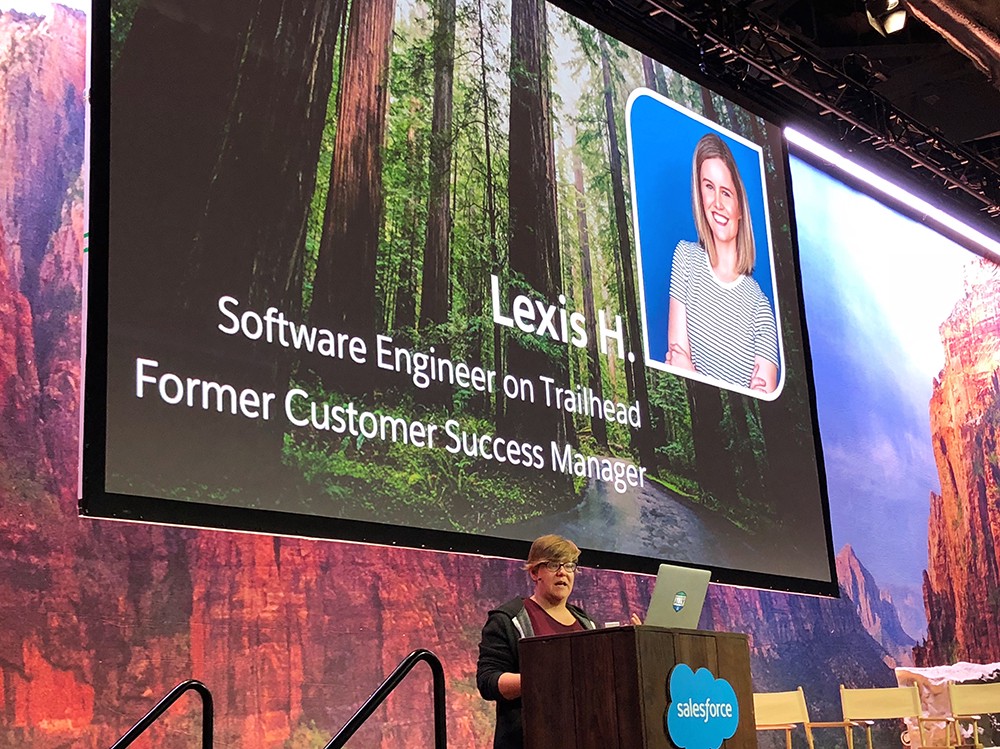The top college degrees that were trending back when you were in school might not seem so hot today. Let’s face it: by the time four (or more) years have flown by, a lot changes. Salesforce Software Engineer Lexis Hanson studied finance in college. But before she finished her degree, she got the tech itch.

After graduation, Lexis joined a software company as an internal consultant. From there she landed a gig on the Customer Success team at RelateIQ, which had recently been acquired by Salesforce.
Lexis started to carve her path at Salesforce by onboarding customers to Salesforce Essentials, an out-of-the box customer relationship management (CRM) for small businesses that sets up in minutes. By asking the right questions, she helped customers reimagine their business processes. After nine months in the role, Lexis was ready for a new challenge. She wanted to code.
The decision to pivot to this new career was simple. But her journey to manifesting this dream required unrelenting commitment. If you’re interested in transforming an “unlikely” opportunity into a reality, then consider Lexis’ approach.
1. Find a Supportive Network
“Over lunch, I would talk to the Software Engineers about their roles. I shared with my coworkers that I wanted to code and asked them where I should start. The best advice was ‘just pick a language and stick with it. Don’t get distracted by framework and noise. Everything else will come to you.’”
Be bold in your pursuit of mentors — so many professionals want to pay it forward and root for your success, especially at Salesforce! Try reaching out to someone who’s in a role you’re curious about, and ask what is needed to flourish in that position.
2. Commit to Progress
In 18 months, Lexis learned a skill set that traditional students develop in a four-year period.
“It took me a year and a half studying outside of work with nearly every free hour I had. It’s hard to stick with something that long. Make that commitment to spend a certain amount of time each week.”
While Lexis knew she had to study diligently to achieve her goals, she also prioritized wellbeing to avoid burnout.
“After a long day, I’d opt to do something lighter. Maybe watch a video rather than coding a project.”
A little flexibility in your schedule will go a long way toward keeping your batteries charged!
3. Cater to Your Learning Style
Colleagues recommended several training resources, some of which were great, and others that didn’t jive for her.
“Not every resource works for every person. I had to learn quickly to close out the noise.”
By far, Lexis’ favorite tools were self-paced tutorials. Trailhead, Salesforce’s guided learning platform, offers just that. Access our free training to skill up for the future and grow your career.
4. Try, Try, and Try Again
After attending a conference for developers, Lexis was inspired to put her skills to the test by coding a real-world project.
Taking a page from her finance background, Lexis built an app that translated prices to cryptocurrency.
“I was building an app for a brand new connected device. Because the product was so new, there wasn’t a strong community. That made my project particularly challenging. I sent in my app 11 times. And 11 times it was rejected — without feedback. But I continued working on it for three months, and it was approved on the twelfth try!”
5. Ask to Receive
Lexis craved an immersive experience working alongside other Software Engineers, but she was way past the traditional intern stage. Then she ran into a Salesforce Software Engineering Manager at a meetup and asked about shadowing opportunities.
“He offered to let me work with his team a couple days a week! My manager and VP wanted to support me in this transition, and I’m so grateful they found ways to make this opportunity feasible.”
6. Tell Your Story
For people making career changes, their resume often doesn’t tell the full story. Lexis had developed the skills, built her portfolio, and confirmed that software engineering lived up to her expectations. But her resume still leaned heavily towards consultative work experience and her finance degree.
In addition to reworking her applications to showcase her training, special projects, and participation in industry organizations, Lexis had to once again get out of her comfort zone… this time practicing some self-promotion.
“I’d been watching internal career posts for a long time, so I knew what to study. In January I started applying. My first applications were rejected outright. Given my nontraditional background, I realized I needed to preface my application with a story. I crafted a cover letter to feature the projects I’d been working on and offer to connect for an informal chat if the recruiter or hiring manager wanted to learn more.”

Lexis reflected, “My journey to this role was a great reminder that your dream job isn’t just a matter of background and fit, but also timing. Being transparent with the recruiter about my personal goals throughout the interview process helped us align and make this happen!”
If you find yourself wondering what life could look life if you’d taken a different path, then don’t daydream — pivot! Lexis’ story shows us the raw power of chasing your passions. And there’s no better environment than Salesforce in which to do it.
To prepare for your next role, explore Trailhead and chart your course for Salesforce. Or, if you’re ready to dive in, apply for your next role today!






